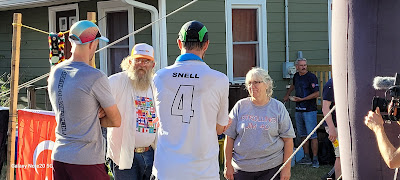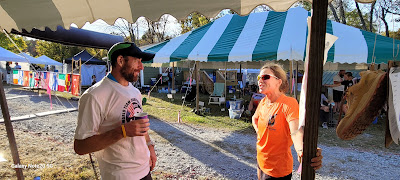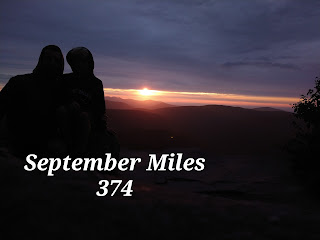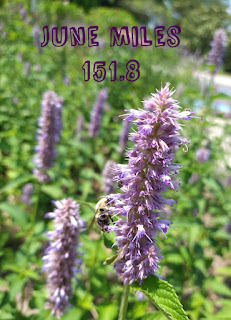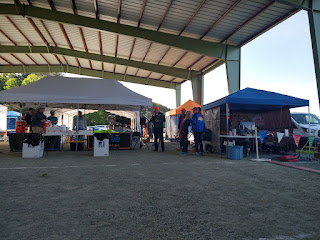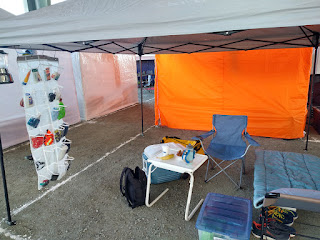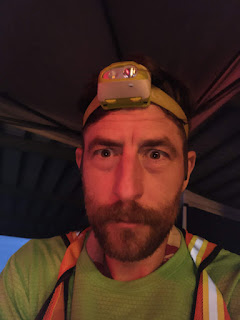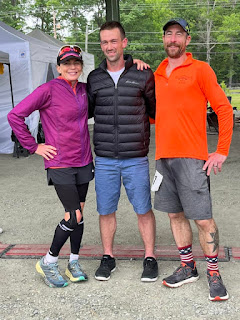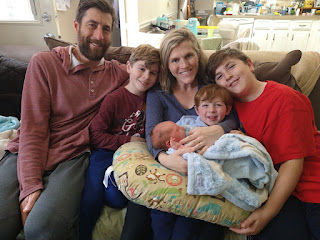| Prerace photo with my awesome crew man, Marty! |
I’ve run Big’s Backyard for the last two years and both years I put in more training and preparation than I had for any other race. And both years the course sent me home feeling defeated after serving me up with a heaping pile of humble pie. Coming up short of your goals and facing failure can be tough and is usually not a pleasant experience, but it can also be a learning experience that helps us grow and improve in our pursuit. With a few weeks between me and my second DNF at Big’s, I feel like I’ve handled this one emotionally better than the first and I am certain I have learned from this one.
This year’s edition of Big’s Backyard was the Individual World Championship competition, so slightly different from last year’s World Team Competition. The backyard international championship competitions are currently conducted annually alternating between an individual competition (on odd years) held on the original backyard course in Bell Buckle, TN and national team competitions (on even years) run remotely as a satellite competition at the home course of each team. The standard backyard rules apply for both types of competition, but there are some intricate differences between the two types of competitions.
Since this was my first time competing in the Backyard Individual World Championship, it felt much different than last year and felt like a pretty big deal to me. I had some really high hopes for my performance and my lowest goal in my set of cascading goals was to improve my PR of 62 yards for the course. Unfortunately, I failed to reach my lowest goal and my remaining goals only went up from there, far out of my reach.
Day 1:
The first day on the trails felt good overall and actually went by pretty quickly. The first 11 hours on the trail felt relatively easy compared to how difficult I remembered the trail being from last year. I spent much of the day meeting and chatting with some of the best backyard runners from all over the world. The rest of the day was spent catching up with the American runners that I ran with as a part of Team USA last year. Some of them I had run with only a few months earlier at Capital Backyard Ultra, but others I had not seen since last year at Big’s. With all of the socializing and just refamiliarizing myself with the trail and my time check points, the first day of trail yards was over before I knew it. It seemed minor at the time, but I was having some intestinal issues and making more stops at the porta potties than I probably should have. I figured it was just nerves and would get better as the race progressed, but in hindsight it may have been more akin to the “pebble in the shoe” analogy where it seems like a minor inconvenience until it leads to a painful blister that really can’t be fixed.
Night 1:
The first night on the road brought back many memories. The sky was clear and filled with stars. The temperature was comfortable for which I was very thankful as it was the extreme drop in temperature and strong winds that I credited with a heavy dose of the blame as to why I quit when I did last year. The road yards really felt like a continuation of the first day. As every runner’s pace changed a bit from trail to road, I found myself still meeting new runners throughout the night which helped pass the time and ward off sleepiness. I never felt too sleepy the first night and as the sun rose on the last road yard, I felt refreshed and excited to go back to the trails.
 |
| Still early on day 3, I think. |
Day 2:
My legs felt good to start the second day of trail running and I didn’t feel too sleep deprived for having run through most of the night. I was still feeling good at this point of the race. I think it was at some point during the second day that I tried to address the intestinal issues I was still having. I took some anti diarrhea medicine to help treat it. I also stopped taking the gels I had been eating hourly and cut off the coconut water I had been drinking between yards. The thought was that I may have been taking in too much sugar or the coconut water was acting as a laxative. I’ve used coconut water at plenty of other backyards and never had these issues, but I had brought a different brand for this race. Ultimately, I don’t know what the cause was, but we were trying to resolve the problem as quickly as possible which meant getting rid of the two readily apparent possible causes. As day two continued, fatigue began to set in and the overall difficulty of completing each yard seemed to be mounting with every yard. I continued grinding and looking forward to the switch back to the road even though I knew it would bring with it the challenge of a second night of sleep deprived running. For those last few day yards on the trail I couldn’t stop thinking about how the trail felt more difficult this year on the second day than it did last year and what an extreme change I had in my perception of difficulty in just 24 hours. My perception of the trail difficulty had made a full reversal: from much easier than I remembered to tougher than I remembered.
Night 2:
It was during the second night that the thoughts of how I was not going to have the race I had envisioned began to materialize more completely, seem more real, and become much more difficult to suppress. I was feeling more sleepy than the first night but not getting much sleep in the few minutes I closed my eyes between each yard. I didn’t feel like I was working super hard, but still I was only coming in with about 7 to 8 minutes to spare. On top of it, I was still having some gastrointestinal issues, so much so that after one of the middle of the night yards I had to make a quick impromptu underwear change (please don’t ask for details, it was bad, but could have been far worse). The second night presented far more challenges than I expected going into this race. Thankfully, I was able to overcome them and survive to see another sunrise thanks in big part to the persistence of my crew and the other runners. My crew man, Marty, did all he could to keep me focused, fed,motivated, and on task even when my attitude in the crew area was pretty crappy. The other runners I ran with during the second night helped keep me motivated to continue pushing at a decent pace as well as keeping me engaged in some conversation to avoid falling asleep while running. The three runners that stand out for me that I ran with when I most needed someone to run with were Jivee Tolentino (who I chatted with for the first time during the second night), Thembinkosi Sojola, and Jason Bigonia. I can’t express how valuable it was to me to share those miles with them in the wee hours of the morning as I was desperately looking forward to the sunrise.
 |
| Morning of Day 3, when I was overdressed and still had my headlamp on. |
After the second night, my legs were feeling pretty shot and I was uncertain how they would react when we switched back to the trails. I had the same worry last year, fearing my legs would be dead when they hit the trail again and I would time out on the first trail yard of the third day. With that worry in my head again, I hit the half mile road out and back section at a relatively faster pace to bank some time before the remainder of the day course that is all single track trail with some sections that are a bit on the technical side. It surprised me again this year, just like last year, how good my legs felt getting back on the trail after the second night. Other than being overdressed for the weather (I had failed to change out of my long sleeve shirt and kick off my running pants that I had put on as temperatures got a bit lower during the second night) the first yard of day three on the trails was honestly one of my most enjoyable. As I ran that yard, I started to think that maybe things were starting to turn around for my race. Even though I had to make another emergency roadside bio-break (all the while one of the camera drones hovered above my head) on the last road yard, I thought maybe that was the last of my digestive issues. Maybe day three will finally be the smooth sailing yards that I had expected early in the race.
 |
| Post race interview. |
The next few yards got a bit more challenging, but I was still completing them with 3-4 minutes to spare. That went on until yard 54. Early during that yard I got a bad feeling in my stomach. I thought I was going to vomit and my race was going to be over as I assumed I would likely time out after I emptied my stomach. Only a few moments later, I realized I wasn’t going to vomit but it was about to come out the other end. After I took care of business, my stomach felt better but I was unsure if I would complete the yard before I timed out. I knew I’d have to work for it so I immediately started pushing the pace. It was a struggle, but I made it in almost a full minute before the three minute whistle. Unfortunately, pushing the pace to make up that lost time took a toll on me physically and stressed me out. Which was basically the story for the remainder of my race. I’d go out easy to start the yard in an effort to try to recover from pushing hard during the second half of the previous yard. It felt like I was in a backyard death spiral for the last four yards of my race and I was panicking. It felt like my race was slipping away and there was no way to save it.
I had fallen at least a few minutes behind the pace necessary to complete my 57th yard before the halfway point. I’m still not sure how I fell so far off pace so early in that yard, but that’s where I found myself when I caught up with my fellow Team USA member, Levi Yoder. I think we both knew that we were in some trouble at that point, so we both worked together to pick up our pace and push one another. It felt like we pushed really hard for the last two miles of that yard; like red lining and going into a kick to cross the finish line. In reality, we probably barely broke a 10 minute mile if at all. Based on checkpoints we passed as we were hammering, I was estimating we’d complete our yard somewhere between the second and third whistles. We managed to cross the line about one second before the two minute whistle. I’m not sure about where Levi’s mind was at the time, but I was pretty certain my legs would be dead after that push. Levi and I left the corral at a shuffling pace for yard 58, but I think we were still laughing at the time at how ridiculously hard we pushed to complete that last yard. We walked the road out and back debating whether to even go back out on the trail. We agreed to force ourselves to run back through the starting corral on the way to the trailhead. We managed that, but when we got to the start of the trail we both stopped. We had a short discussion about how we would have to hammer the next three miles to complete the yard before the cut off which felt like an impossibility at the time. And so we both pulled the plug right there, turned away from the trail, and walked back to the starting corral.
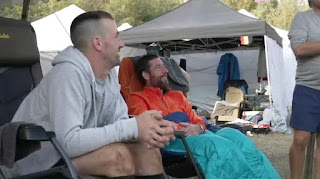 |
| First time sitting down to relax after the race. |
The feeling of mixed emotions hit soon after as everyone in camp started clapping and cheering for us as we walked back. I was still in the midst of laughing at how the last yard ended when the reaction from everyone at camp suddenly reminded me that it was all over and my race was done. Relief, regret, joy, and disappointment all at once. Even now, nearly three weeks later, I still wonder what would have happened had we continued down the trail. Would some spark of life for a fight to survive and continue have ignited and powered my legs to complete one more yard? I don’t know. I don’t think so, but I like to think it would have at least been a possibility. That’s often the attraction and aversion of the backyard format, in my experience. Each race leaves you questioning. Did I do enough? Could I have done more? Where did it go wrong? Where can I improve? When can I try again?
 |
| About half of 2022 Team USA - Jason Bigonia, Levi Yoder, Dan Yovichin, Rick Kwiatski, Scott Snell, Keith Van, Kevin McCabe, and Piotr Chadovich |
I want to preface this lesson with a quote from a fellow runner at Big's this year and a member of last year's US Team, Dan Yovichin, - “We’re just ordinary people doing extraordinary things.” I think I got it right, or at least close to right. I recall him saying it last year, but this year it hit me a little differently and applies to the major mistake I made and what I learned from it. I made my big mistake before the race even started, before I left home for Bell Buckle, the seed for it probably germinated and began to take root during my training runs between Capital and Big's. What was my great folly? I failed to prepare myself for the fact that accomplishing extraordinary feats is extremely difficult.
I went into this race overconfident. Then when it got hard, it was shocking. I had been telling myself while preparing that I could definitely make it to the third night and then it would start getting tough. All the while, diminishing the facts that running through two consecutive nights with minimal sleep is tough, covering 200 continuous miles on foot is challenging regardless of the pace, and maintaining normal bodily functions while adhering to the backyard race format time requirements can present additional challenges. So when things got tough and I started struggling more than I expected to during that third day, I wasn't prepared. I panicked. Which I believe made matters even worse, mentally and physically, as I felt like I had lost control. The feeling of panic was at least partially caused by my overconfidence and the unexpected shock of how much I was struggling earlier than I had planned. This concept of a misalignment of actual and expected demands in relation to our capabilities is a topic Steve Magness discusses at length in his book Do Hard Things. I read the book in part to prepare for Big's, so there was no excuse for me to make this mistake other than it is an easy trap to fall into. Magness explains how this blunder often plays out when a goal begins to feel impossible to achieve, stating that we’re more likely to “abandon our pursuit” because why try and continue to suffer if it will just end in failure anyway? Rather than me relaying the information, here’s a short quote from the book:
“When we are overconfident, we set ourselves up for failure. This isn’t idle conjecture: researchers have found this phenomenon in everything from competing in sports to deciding whether to stay in a relationship or quit your job. It’s easy to feel confident in the beginning but when we come face-to-face with the reality that we might fall short of our goal, we experience what psychologists call an action crisis.”
Since I read the book, I should have learned this lesson already, but sometimes it takes experience to learn a lesson. At least I hope that this experience has taught me this lesson well enough so that I remember it and do not repeat it at future backyard races.
Scott Snell
9 November 2023
 |
| Cheering on the remaining runners was almost as much fun as running a backyard. |


